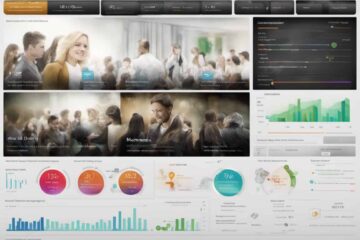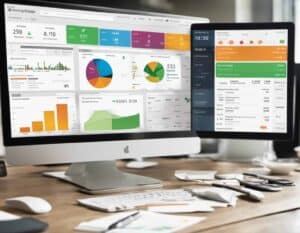Most successful sales teams rely on efficient sales management tools to streamline their operations and boost productivity. In the fast-paced world of sales, having the right software can make all the difference in achieving targets and increasing revenue.
This blog post will explore the imperative tools and features that sales manager software offers to help you master your sales management strategies and drive your team towards success.
The Role of a Sales Manager
For a sales manager, the key responsibilities revolve around leading and motivating the sales team to achieve set targets, developing sales strategies, monitoring sales performance, and providing guidance and training to team members.
It is crucial for a sales manager to effectively communicate goals and expectations to ensure the team is aligned and focused on driving revenue growth.
Challenges faced by sales managers include fluctuating market conditions, evolving customer needs, and internal team dynamics. To overcome these challenges, sales managers can implement regular training programs, utilize sales management software for data-driven decision-making, and foster a culture of open communication within the team.
By addressing these challenges proactively, sales managers can enhance team performance and drive success.
Afterall, the role of a sales manager is multifaceted, requiring a mix of leadership, strategic thinking, and problem-solving skills to navigate the dynamic sales environment effectively.
Core Features of Sales Manager Software
In the dynamic world of sales, leveraging the right tools is crucial for success. Sales manager software comes equipped with a suite of core features designed to optimize sales processes, enhance customer relationships, and drive revenue growth.
- CRM Tools: Facilitates tracking of customer interactions and lead management, enhancing communication and streamlining sales processes for revenue growth.
- Lead Management: Allows for effective organization and tracking of potential clients, ensuring timely follow-ups and improved conversion rates.
- Sales Pipeline Management: Offers visibility into every stage of the sales process, helping sales teams to prioritize and focus on deals that are most likely to close.
- Analytics: Provides valuable insights into sales trends and customer behavior, enabling informed decision-making and strategy optimization.
- Predictive Analytics: Utilizes historical data and market trends to forecast future sales, aiding in the anticipation of customer needs and market demands.
- Sales Forecasting: Employs predictive modeling to project future sales performance accurately, enabling realistic target setting and effective resource allocation.
- Resource Allocation: Helps in identifying optimal ways to distribute resources (including time and personnel) based on predictive insights, ensuring the highest efficiency and impact on sales outcomes.
Harnessing these core features effectively enables sales managers to navigate the complexities of the sales landscape with precision, ensuring sustained business growth and success.
Advanced Tools for Sales Optimization
Advanced tools for sales optimization are key in refining sales processes and boosting team performance.
Beest.app stands out as a comprehensive sales optimization software designed to streamline operations, enhance productivity, and elevate sales effectiveness. It offers a suite of features aimed at improving various aspects of the sales process, from campaign management to customer engagement and data analysis.
- Campaign Creation and Management: Users can create, access, and manage all their campaigns, customizing each with specific names, dates, types, and location settings.
- Pre-configured Dashboards and Pivoting Tools: Simplify the analysis of sales data with easy-to-use dashboards and tools for in-depth insights.
- User and Customer List Management: Add users to campaigns and import customer lists for targeted engagement strategies.
- Mapping and Area Allocation: Define specific areas for user activity, including no-go zones, and manage locations and resources efficiently.
- Resource Sharing and Form Creation: Upload presentations, create forms, and share resources effortlessly, supporting sales teams with the right materials.
- Product Customization and Performance Metrics: Set up products within the app and define metrics for harmonizing performance across teams.
- Automated Communication Routines: Schedule automatic SMS, emails, or calls to maintain engagement with clients and prospects.
- Knowledge Tests for Sales Reps: Ensure your sales team’s product knowledge is up-to-date with easy-to-create tests and track passing scores.
- Gamification: Drive sales team motivation and engagement with badges, rewards, and competitions.
- Live Maps and Tracking: Utilize GPS route planning and live tracking for efficient sales visits and data collection.
- Report Building: Customizable reports allow for quick generation of vital sales data and performance indicators.
- Smart QA and Fraud Control: Maintain high standards of quality and security with tools for real-time fraud control and compliance monitoring.
Beest.app equips sales teams with advanced tools and functionalities to streamline their sales processes, making it an essential asset for sales optimization.

Integrating Sales Software and Mastering Sales Management
Integrating sales software with business operations is essential for modernizing sales strategies and ensuring efficiency across the board.
Automation, real-time collaboration, and data accessibility are key factors that, when effectively integrated, can transform the sales process, making it more agile and responsive to customer needs.
1. Streamline Lead Management
Effective lead management ensures a smooth transition from potential prospects to loyal customers. By automating lead capture and follow-up processes, businesses can increase conversion rates and improve sales cycle efficiency.
- Automate lead capture from all channels into a centralized system.
- Use scoring models to prioritize leads based on engagement and potential value.
- Set up automated follow-up emails for different stages of the lead journey.
- Implement lead nurturing programs tailored to each segment.
2. Automate Workflow Processes
Workflow automation reduces manual tasks, allowing sales teams to focus on selling rather than administrative tasks. Automating sales processes ensures consistency, reduces errors, and speeds up the sales cycle.
- Identify repetitive tasks that can be automated, such as data entry or report generation.
- Use sales software to create automated workflows for approvals, alerts, and reminders.
- Implement triggers for follow-up tasks based on customer actions or deal stages.
- Regularly review and optimize automated workflows for continuous improvement.
3. Enhance Collaboration Across Teams
Fostering collaboration across sales, marketing, and customer service teams ensures a unified approach to customer engagement. Collaborative tools within sales software can enhance communication and streamline coordination.
- Utilize shared dashboards and reports for a unified view of sales metrics and customer interactions.
- Implement team messaging and file-sharing features to improve communication.
- Schedule regular cross-departmental meetings to align strategies and share insights.
- Encourage the use of collaborative project management tools for joint initiatives.
4. Leverage Mobile Accessibility
Mobile access to sales software allows teams to stay connected and responsive no matter where they are. This mobility ensures that sales opportunities are never missed and customer inquiries are addressed promptly.
- Ensure the sales software has a mobile app or is mobile-friendly.
- Train sales teams on mobile features and best practices for security.
- Use mobile notifications to alert teams of urgent tasks or updates.
- Encourage the use of mobile apps for updating CRM data in real-time.
5. Integrate Sales Data Across Systems
Integrating sales software with other business systems, such as ERP or marketing automation tools, provides a comprehensive view of customer interactions and sales performance.
This integration ensures data consistency and enhances decision-making.
- Use APIs or middleware solutions to connect sales software with other business applications.
- Ensure data synchronization across systems to avoid discrepancies.
- Regularly clean and maintain data quality within integrated systems.
- Leverage integrated analytics to gain insights across different business functions.
6. Implement Continuous Training and Support
Continuous training ensures that sales teams are maximizing the use of sales software features. Regular training sessions and support materials can help teams stay updated on new features and best practices.
- Develop a training program that includes initial training and ongoing refresher courses.
- Utilize online tutorials, webinars, and documentation for self-service learning.
- Provide access to a help desk or support team for software-related inquiries.
- Encourage feedback from teams on training needs and software usability.
7. Measure and Optimize Sales Performance
Using sales software to measure performance against key metrics allows for continual optimization of sales strategies. Regularly reviewing sales data helps identify areas for improvement and success.
- Set clear KPIs for sales performance and track them within the sales software.
- Use dashboards and reports to monitor progress and trends.
- Conduct regular sales reviews to discuss performance and address challenges.
- Leverage analytics to refine sales tactics and strategies based on data insights.
Integrating sales software with business operations not only streamlines the sales process but also enables a more strategic approach to sales management. By following these strategies and actionable tips, businesses can ensure their sales teams are well-equipped to meet and exceed sales targets.
Choosing the Right Sales Manager Software
Choosing the right sales manager software is a pivotal decision for sales leaders aiming to streamline their sales processes and enhance team performance.
Identifying software that encompasses both essential functionalities and the capability for growth and customization is key to supporting long-term sales strategies and operational efficiency.
- Lead Management: An efficient lead management system is foundational for tracking and nurturing leads through the sales funnel. The software should offer comprehensive tools for capturing, scoring, and nurturing leads to improve conversion rates.
- Sales Forecasting: Accurate sales forecasting tools help managers predict future sales and set realistic targets. Look for software that employs predictive analytics for more accurate forecasting, enabling better resource allocation and strategy planning.
- Pipeline Tracking: Visibility into the sales pipeline allows for effective monitoring of deals at various stages. The right software will provide detailed insights into the pipeline, helping managers identify bottlenecks and opportunities for acceleration.
- Performance Analytics: Analytics and reporting features are crucial for evaluating sales activities and team performance. Ensure the software delivers actionable insights through customizable reports and dashboards to drive sales strategy and performance improvements.
- Scalability and Customization: As your business grows, your sales management software should easily scale and adapt to your evolving needs. It should offer flexible customization options to match your specific sales processes and integrate seamlessly with other tools and systems.
Beest.app excels as a top-notch sales management tool that covers all essential needs effectively. It offers superior lead management to track and care for every lead, along with predictive forecasting and detailed pipeline views for better strategy and quick decisions.
The software’s analytics provide insights into team performance and sales results, helping to fine-tune sales tactics. It can also scale and customize to fit your business as it grows, offering more features like mobile access and gamification to improve the user experience.
Essentially, Beest.app has everything sales leaders need to boost sales growth efficiently.

Final Thoughts | Unlock Your Sales Team’s Full Potential
After delving into the essential tools and features of sales manager software, it’s unmistakable that the secret to excelling in sales management lies in harnessing the power of technology.
Such software is pivotal in refining sales operations, bolstering team synergy, and elevating productivity to new heights.
By adeptly employing these tools, sales managers are equipped to unearth critical insights, monitor vital metrics, and execute strategic decisions that propel their teams forward.
In the quest to remain at the forefront of the ever-changing business arena, the investment in top-tier field sales management software isn’t just advisable—it’s indispensable.
Embrace the future of sales management today, and lead your team to unparalleled success.


